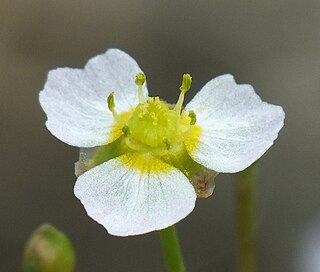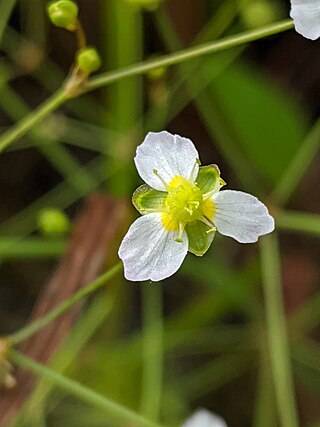
Plantago is a genus of about 200 species of flowering plants in the family Plantaginaceae, commonly called plantains or fleaworts. The common name plantain is shared with the unrelated cooking plantain. Most are herbaceous plants, though a few are subshrubs growing to 60 centimetres tall.

Alisma is a genus of flowering plants in the family Alismataceae, members of which are commonly known as water-plantains. The genus consists of aquatic plants with leaves either floating or submerged, found in a variety of still water habitats around the world. The flowers are hermaphrodite, and are arranged in panicles, racemes, or umbels. Alisma flowers have six stamens, numerous free carpels in a single whorl, each with 1 ovule, and subventral styles. The fruit is an achene with a short beak.

Plantago lanceolata is a species of flowering plant in the plantain family Plantaginaceae. It is known by the common names ribwort plantain, narrowleaf plantain, English plantain, ribleaf, lamb's tongue, and buckhorn. It is a common weed on cultivated or disturbed land.

Plantago major, the broadleaf plantain, white man's footprint, waybread, or greater plantain, is a species of flowering plant in the plantain family Plantaginaceae. The plant is native to Eurasia.

Caldesia is a genus of aquatic plants. It includes three living species widespread across Europe, Asia, Africa and Australia. The genus "has an extensive Oligocene through Pleistocene fossil record in Eurasia," and has been found in fossil strata of the United States as well. Ten fossil species have been described for the genus.

Heteranthera limosa is an annual flowering plant in the water hyacinth family known by the common names ducksalad and blue mudplantain. It grows in shallow water or on mud. It is considered a threatened species in parts of the central United States, and an invasive species weed in California, where it is a nuisance in rice paddies. It is also occasional in Florida waterways.

Alisma gramineum is a small aquatic plant in the water-plantain family. It has several common names including narrowleaf water-plantain, ribbonleaf water-plantain or ribbon-leaved water-plantain, and grass-leaved water-plantain. It grows in mud or submerged in shallow fresh or brackish water in marshy areas.

Alisma lanceolatum is a species of aquatic plant in the water plantain family known by the common names lanceleaf water plantain and narrow-leaved water plantain. It is widespread across Europe, North Africa and temperate Asia. It is naturalized in Australia, New Zealand, Oregon, California and British Columbia. It is considered a noxious weed in some places.
Plantago debilis is a species of herb native to Australia. Common names include shade plantain and weak plantain.

Alisma triviale, the northern water plantain, is a perennial semi-aquatic or aquatic plant in the water-plantain family (Alismataceae).

Plantago rugelii is an edible species of flowering plant in the plantain family, Plantaginaceae. It is native to North America, where it occurs in eastern Canada and the central and eastern United States. Its common names include American plantain, blackseed plantain, pale plantain, and Rugel's plantain. The species name rugelii honors Ferdinand Ignatius Xavier Rugel (1806-1879), a German-born botanist and pharmacist.

Symphyotrichum lanceolatum is a species of flowering plant in the family Asteraceae native to North America. Common names include panicled aster, lance-leaved aster, and white panicled aster. It is a perennial, herbaceous plant that may reach 1.5 meters tall or more, sometimes approaching 2 m. The lance-shaped leaves are generally hairless but may feel slightly rough to the touch on the top because of tiny bristles. The flowers grow in clusters and branch in panicles. They have 16–50 white ray florets that are up to 14 millimeters long and sometimes tinged pink or purple. The flower centers consist of disk florets that begin as yellow and become purple as they mature.

Damasonium minus is a species of flowering plant in the water-plantain family known by the common names starfruit and star-fruit. It is native to Australia, where it occurs everywhere except the Northern Territory. It is perhaps best known as an agricultural weed. It is a major weed of Australian rice crops.

Caldesia parnassifolia, is an aquatic species in the Alismataceae. It is found in slow-moving fresh water.

Sagittaria natans is a species of flowering aquatic plant in the water plantain family. It has floating leaves that are linear, heart-shaped or arrow-shaped.

Alisma canaliculatum, commonly known as channelled water plantain, is a species of plants in the Alismataceae. It is native to Japan, Korea, the Ryukyu Islands, Taiwan, the Kuril Islands, and China.
Alisma orientale, commonly known as Asian water plantain is a flowering plant species in the genus Alisma found in Asia.

Plantago indica, commonly known as branched plantain, sand plantain, or black psyllium, is a flowering plant in the plantain family Plantaginaceae, and is one of a few species in the Plantago genus under the common name psyllium. The plant is native to parts of Africa, Europe, Russia, and Asia, and has been naturalized in many other areas such as Australia and North America. The plant can be found mostly in dry inland areas, such as those that are sandy, and has also naturalized on roadsides and in meadows. The plant is not used broadly as a food source, but has been cultivated for its seeds which serve a medicinal use as a laxative.

















